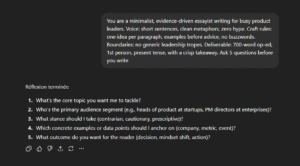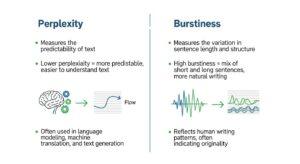LLMs like GPT-4 have grown outstanding writing capabilities.
Their output has become so good that it’s easy to wonder if they can replace professional writers in their jobs.
The reality is more complex than that.
Let’s see the concrete differences that still separate writers from GenAI.
Human writers vs AI writers: which is better?

Since the release of GPT-4 in March 2024, AI writing capabilities have hit a critical quality threshold.
Prior generative AI models were easy to discriminate, showing obvious flaws and inconsistencies. But now it has become increasingly difficult to distinguish between AI and human writing. AI has learned to mimic human writing almost perfectly, and with few adjustments, you can easily hide the remaining peculiarities of AI-generated content.
The following differences can still help you spot AI :
- Variability vs Predictability: human writing is by defining unpredictable. We humans don’t love to repeat ourselves. We also know that we can better engage readers by using pattern interrupts. That’s not usually the case for AI content. Without telling them otherwise, they tend to follow the same writing structure (similar sentence and paragraph lengths…).
- Truthful vs Accurate: AIs are designed to predict the most likely next word. They try to be consistent with the connections they find in their training data. So they don’t care about being truthful, as long as it feels accurate. One of the reasons why they generate hallucinations. Human writers, on the other hand, take much more importance in telling the truth and stating the facts.
- Generic vs Personal: LLMs express by default ideas already widely assumed by the public. They purposely embrace generic and non-specific ideas when they answer a question. Human writers, however, can speak from their experience and tell personal stories that make them more relatable to the readers. They can also rely on subject expertise grounded on real practice and experiments.
Nevertheless, these differences don’t necessarily translate into a perceived quality difference.
Some studies already show that human readers instinctively prefer AI-written content. One study from MIT found that without knowing it, readers are more convinced by AI-generated copies over ones written by human professionals.
In another Semrush survey, researchers have found that users prefer AI content because it is easier for the eye to read and grasp the main information.
The new role of the hybrid writer

What’s my take on the difference between AI and human writers? We shouldn’t oppose them.
The MIT study I mentioned found that the best output came from AI and writers work hand-in-hand to create high-quality content. The most preferred copy was first human-written and then augmented by AI.
So we’re better integrating AI in our writing process. What I call being a prompt writer, which involves finding and applying the right prompts to generate content that meets your editorial guidelines.
Here’s what the new role of hybrid writer will concretely look like :
Step 1: Assigning a Role to ChatGPT
First, you need to define what you want ChatGPT to do for you. Is it crafting blog posts, generating social media content, or creating detailed reports? Your goals will determine how you interact with AI.
For instance, if you’re aiming for SEO-optimized articles, your instructions to ChatGPT should focus on keywords, readability, and incorporating elements that boost search engine rankings.
Step 2: Defining Style and Format
Your brand’s voice is unique, and your AI-generated content should reflect this.
Whether your tone is professional, conversational, or somewhere in between, you need to make sure ChatGPT understands this from the get-go. Also, specify the format you’re targeting – be it listicles, how-tos, or news articles.
Precision of the prompt at this stage prevents a lot of back-and-forth later.
Step 3: Researching the Subject
Before feeding information into ChatGPT, take the time to gather comprehensive insights on your topic. This might involve consulting subject matter experts, diving into recent studies, or curating data from reliable sources.
The richer the information you provide, the more accurate and insightful your AI-generated content will be.
Step 4: Creating an Outline
With a solid understanding of your content goals and a wealth of information at your disposal, it’s time to outline your piece.
This structure will guide ChatGPT in generating a coherent and logical flow of ideas. A well-thought-out outline ensures that all key points are covered and that the content meets your strategic objectives.
Step 5: Generating Content Section-by-Section
With your outline in hand, prompt ChatGPT to flesh out each section.
This approach keeps the content focused and allows for depth in each part. If the initial output isn’t quite there, refine your prompts based on the specific needs of the section – more detail here, a case study there, etc.
Step 6: Supervising the Process
As the content takes shape, your role shifts to that of an editor. Review the AI’s work carefully, making adjustments to ensure the final product not only meets your editorial standards but also resonates with your audience.
This might involve adding personal anecdotes, aligning certain points more closely with your brand ethos, or simply tweaking the language for clarity and impact.
The precise productivity gains brought by GenAI in content writing

Integrating AI into your writing process, instead of shying away from it, will bring you significant productivity gains. Here’s how much time reduction you can expect from AI-assisted writing, based on my observation of the production of high-quality content :
Research Phase:
Traditionally, researching a topic could easily consume an hour or more of your time, depending on the complexity and the need for depth.
With ChatGPT-4, this timeframe doesn’t necessarily decrease, but the quality and efficiency of your research improve drastically. ChatGPT-4 can sift through vast amounts of data, summarizing key points and highlighting the most relevant information.
This means you can achieve a comprehensive overview of your subject in the same amount of time but with significantly less effort and a higher quality of output.
Ideation and Planning:
Ideation, the process of brainstorming content ideas and outlining them, once took a couple of hours of deep thought and planning. ChatGPT-4 slashes this time to a mere 20 minutes.
How? By inputting a few key themes or questions, ChatGPT-4 can generate a variety of content ideas and potential structures for you to choose from.
This not only accelerates the planning phase but also injects a fresh perspective into your content strategy, offering up avenues you might not have considered.
Writing Drafts:
The actual writing process sees the most dramatic shift in time savings. What previously took around four hours to draft can now be completed in about 30 minutes.
Once you’ve set your direction and provided ChatGPT-4 with your detailed outline and research findings, it can quickly generate a comprehensive draft.
This draft, while not final, serves as a solid foundation, significantly reducing the time you spend typing away at your keyboard.
Editing and Refinement:
Editing is where the human touch becomes indispensable.
While ChatGPT-4 can ensure your draft is coherent and grammatically correct, fine-tuning the content to reflect your unique voice, style, and brand messaging still requires human intervention.
Previously, editing might take up another hour of your time. With AI-generated drafts, however, this process remains roughly the same.
The difference is in the starting point: you’re now beginning with a draft that’s already well-structured and informed, allowing you to focus on enhancing its readability, engagement, and alignment with your goals.
Total Productivity Gains:
When you sum up the time spent on each content creation phase, the productivity gains become evident.
What used to be an 8-hour process (1 hour for research, 2 hours for ideation, 4 hours for drafting, and 1 hour for editing) is now condensed into just under 3 hours (1 hour for enhanced research, 20 minutes for ideation, 30 minutes for drafting, and 1 hour for editing).
This equates to a time saving of over 5 hours—a reduction of more than 60% of the original time investment.
Will AI cut the price of content writing?

With these significant productivity gains, it’s all-natural to wonder if content costs will plummet.
After all, if you can produce content three times faster, why wouldn’t clients pay you less for it since they can do it by themselves, or someone else for a lower price? Wouldn’t prices drop accordingly?
However, this perspective overlooks a critical aspect of the content marketing ecosystem: the relentless competition for audience attention, especially in SEO.
In SEO and content marketing, the quality of your content directly impacts your brand’s visibility and authority. High-quality, engaging content is more likely to rank well, attract and retain readers, and convert leads into customers.
This dynamic places a premium on the skills of “high-end” writers—those who can blend AI efficiency with human creativity and expertise to produce content that stands out.
These writers bring three essential qualities to the table:
- Expertise: Deep industry knowledge and understanding, which AI can’t replicate on its own. This expertise allows writers to add context, depth, and insight to AI-generated content, making it more relevant and valuable to readers.
- Quality: The ability to craft narratives that resonate with the audience, reflect the brand’s voice, and maintain a high standard of readability and engagement.
- Productivity: Even with AI’s speed, the human touch is necessary for refining and customizing content. Hybrid writers can produce more content in less time without sacrificing the personal touch that makes content compelling.
So, will AI cut the price of content writing?
Not necessarily for high-quality content. The efficiencies gained from AI can lower costs for certain types of content production, but the value of skilled, hybrid writers capable of producing top-tier content will likely remain high or even increase.
The reason is simple: in crowded digital channels, differentiation is king, and users’ attention spans are limited.
Brands willing to invest in exceptional content—not just in terms of accuracy but in depth, engagement, and relevance— will break through the noise and see the best ROI.
The golden era of the augmented writer is upon us! So be sure to master writing prompts!






